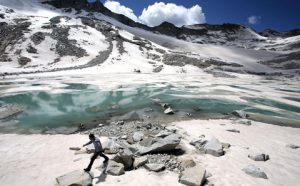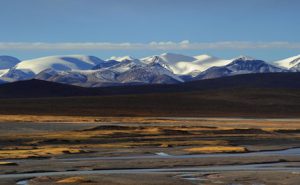The giant panda is adored both in China and around the world, having become a global symbol of conservation ever since the World Wildlife Fund adopted it for its logo in 1961. Sadly, they have also come to symbolise the stark reality of severe global biodiversity loss, especially in China. In Sichuan, one of China’s most populous and fastest developing provinces, the wild panda is becoming increasingly rare. Current estimates put the remaining population near 1,600, with their numbers declining each year.
NH: Your new e-book, Meltdown – China’s Environment Crisis, is a visual journey through China’s deserts, forests, wetlands and the Tibetan Plateau. How did your interest in China’s environment begin? What was your first assignment?
SG: In 2005, I was undertaking an internship at a photojournalism agency in London and discovered the book ‘The River Runs Black’, by Elizabeth C. Economy. The book vividly recounted the state of China’s environment and I was shocked at what I read. At the end of the internship, I received a grant which I decided to use to make my first trip to China.
The first environmental project I undertook was looking at the issues of desertification in western China. After I moved to Beijing, I travelled to Dunhuang in Gansu province. I spent a week documenting the lives of communities on the fringes of the deserts there. I was lucky enough to receive another grant as a result of this work which helped me continue my focus on environmental issues.
NH: What kind of obstacles have you faced when trying to document China’s environmental issues?
SG: My biggest challenges have been mostly logistical. On one trip in China’s western Xinjiang province, I was travelling with a guide and driver to an abandoned city in the eastern reaches of the Taklamakan desert. The journey was completely off-road and we drove for hours to reach the site. On the way we managed to get two flat tyres. We only had one spare which meant our driver had to make his way back to town on his own, leaving us in the middle of the desert to wait. Due to the remote location, we had no cellphone coverage so had no idea if and when he would return. We waited nearly eight hours alone in the desert until he returned. He managed to get a ride with a local passing truck and got back to us just as night was falling.
NH: The book covers seven years of travelling around China- did you notice any changes in people’s attitudes to the environment?
SG: I think attitudes towards the environment are starting to slowly change in China. As the middle class grows, people’s attention is now turning more towards their quality of life.
Most noticeable, for example, has been the recent outcry at the levels of air pollution in Beijing. In January of 2013, the city was hit with extreme levels of pollution that were unique in their severity, even for Beijing. A spark seemed to light amongst the general public, who turned to blogs and social media to vent their concerns. I think this has helped kickstart more of a debate about certain environmental issues.
There is little awareness amongst the general public, however, about the state of some of the country’s ecosystems and native species.
NH: Your book highlights China’s general environmental problems, but also has a keen eye for some of their ironies, such as the huge farm for alligators which can’t be released back into the Yangtze. Can you tell us more about that story?
SG: The Chinese Alligator is one of the most threatened species in China. According to the latest studies, it is estimated there are only 120 individuals left in the wild. Most have disappeared as their natural habitat, wetlands, have been reclaimed for new developments. They have also suffered as a result of poaching.
The Anhui Research Centre for Alligator Reproduction, in the city of Xuancheng in eastern Anhui Province, has been set up for captive breeding of this species. There are now 10,000 individuals in the centre. It has proved quite successful. The problem is that reintroduction into the wild is very difficult – much of the alligator’s natural habitat in the region has been completely destroyed.
NH: Have there been environmental stories in China you wanted to cover but been unable to?
SG: I would have liked to have covered the issue of ‘cancer villages’, especially those affected by water pollution. This is a very sensitive issue in China, so it is hard to get access to the communities most affected. A number of Chinese photojournalists have been able to get access however, so the story has been told.
NH: Do you have any professional contact with Chinese environmental photographers, such as for instance Lu Guang?
SG: I do not normally collaborate with other photographers on projects, however I am aware of the work of Chinese environmental photographers, such as Lu Guang. I admire his work.
The access that local photographers are able to get is advantageous to them and they use it to tell environmental stories from a different perspective. This is very important.
NH: What are the prospects for sustainable environmental tourism in China? How typical was your experience at Dongting lake, which people visit for its natural beauty yet are destroying what they’ve come to enjoy?
SG: I believe the most important aspect of sustainable environmental tourism is education. At the moment when people visit places of special environmental interest in China, such as national parks, there isn’t enough emphasis on educating people about why and how these ecosystems should be protected.
One place that is trying to change this is the Jiuzhaigou National Park, in northern Sichuan Province. Ten thousand people visit the park each day in peak season. They normally enter en masse, travelling around the park in buses, spending a few hours walking around taking pictures and then leave. People come to look, not learn.
A new eco-tour program has been set-up in recent years by rangers at the park, allowing small groups to go into the park with a guide for one, two, or three day hikes. The emphasis is on learning about the forest ecosystems and why we should protect them. It’s a wonderful way to learn about the flora and fauna in the park. At the moment however, 99% of visitors opt for the en masse experience, rather than the eco-tours. I hope this can change in the future.
NH: Do you have any other photo projects planned in China?
SG: Having covered China for so long, I am now looking to turn my attention to other developing nations in Asia. I recently made two trips to Indonesia, to photograph issues related to climate change there. I am also planning to travel to India later this year to begin working on similar environmental issues.
Due to their populations and stages of economic development, I believe China, India and Indonesia are the best countries in Asia to find the most vivid examples of the clashes between humanity and nature.
Meltdown- China’s Environment Crisis is available on Amazon and iTunes




